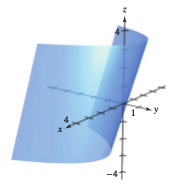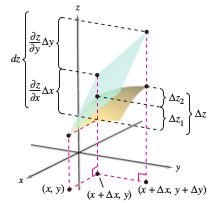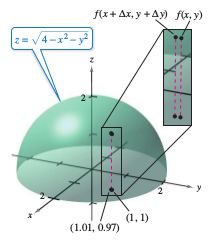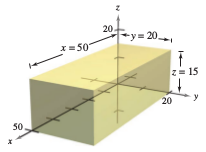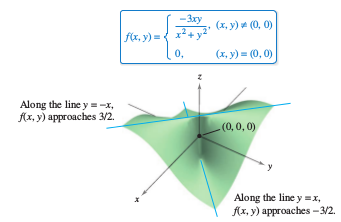Calculus III 13.04 Differentials
| Previous | Calculus III 13.03 Partial Derivatives |
| Next | Calculus III 13.05 Chain Rules for Functions with Several Variables |
Contents
13.04 Differentials
- Increments and differentials.
- Extend differentiability to a function with two variables.
- Use a differential as an approximation.
Increments and Differentials
In this discussion increments and differentials are generalized to functions with two or more variables. Recall from Section 3.9 that for \(y=f(x)\), the differential for \(y\) was defined as
- \( dy = f^{\prime}(x) \: dx \).
Similar terminology is used for a function with two variables, \(z=f(x,y)\). Consider \(\Delta x\) and \(\Delta y\) are the increments for \(x\) and \(y\), and the increment for \(z\) is
- \(\Delta z = f(x+\Delta x, y + \Delta y) - f(x,y). \:\:\:\: \)Increment for \(z\)
Definition 13.4.1 Total Differential
If \(z=f(x,y)\) and \(\Delta x\) and \(\Delta y\) are the increments for \(x\) and \(y\), then the differentials for the independent variables \(x\) and \(y\) are
- \( dx = \Delta x \text{ and } dy=\Delta y \)
and the total differential for the dependent variable \(z\) is
- $$ dz = \frac{\partial z}{\partial x}\: dx + \frac{\partial z}{\partial y}\: dy = f_{x}(x,y)\: dx + f_{y}(x,y) \:dy.$$
This can be extended to functions with three or more variables. For instance, if \(w=f(x,y,z,u)\), then \(dx=\Delta x\), \(dy=\Delta y\), \(dz=\Delta z\), and \(du=\Delta u\) then the total differential for \(w\) is
- $$ dw = \frac{\partial w}{\partial x} \:dx + \frac{\partial w}{\partial y} \:dy + \frac{\partial w}{\partial z} \:dz + \frac{\partial w}{\partial u} \:du.$$
Example 13.4.1 Finding the Total Differential
Find the total differential for each function
a. \( z=2x \sin y - 3x^{2}y^{2}\)
b. \( w=x^{2} + y^{2} + z^{2} \)
Solution
a. The total differential \(dz\) for \(z=2x \sin y - 3x^{2}y^{2}\) is
| \(dz\) | $$= \frac{\partial z}{\partial x} \:dx + \frac{\partial z}{\partial y} \:dy $$ | Total differential \(dz\) |
| \(= (2 \sin y - 6xy^{2})\:dx + (2x \cos y - 6x^{2}y) \: dy. \) |
b. The total differential \(dw\) for \(w= x^{2} + y^{2} + z^{2} \) is
| \(dw\) | $$= \frac{\partial w}{\partial x} \:dx + \frac{\partial w}{\partial y} \:dy + \frac{\partial w}{\partial z} \:dz $$ | Total differential \(dw\) |
| \(= 2x\:dx + 2y \: dy + 2z \:dz. \) |
Differentiability
Definition 13.4.2 Differentiability
A function \(f\) given by \(z=f(x,y)\) is differentiable at \((x_{0}, y_{0})\) if \( \Delta z\) can written in the form
- \( \Delta z = f_{x}(x_{0}, y_{0}) \Delta x + f_{y}(x_{0}, y_{0}) \Delta y + \varepsilon_{1} \Delta x + \varepsilon_{2} \Delta y\)
where both \( \varepsilon_{1} \) and \( \varepsilon_{1} \rightarrow 0\) as
- \( ( \Delta x, \Delta y ) \rightarrow (0,0)\).
The function \(f\) is differentiable in a region \(R\) if it is differentiable at each point in \(R\).
Example 13.4.2 Showing that a Function Is Differentiable
|
|
Show that the function
is differentiable at every point in the plane.
where \(\varepsilon_{1} = \Delta x \) and \( \varepsilon_{2} = 0 \). Because \(\varepsilon_{1} \rightarrow 0 \) and \( \varepsilon_{2} \rightarrow 0 \) as \((\Delta x, \Delta y) \rightarrow (0,0)\), it follows that \(f\) is differentiable at every point in the plane. The graph for \(f\) is shown in Figure 13.4.1. |
Theorem 13.4.1 Sufficient Conditions for Differentiability
The term differentiable is used differently for functions with two variables than for functions with one variable. A function with one variable is differentiable at a point when its derivative exists at the point. For a function with two variables, that the partial derivatives \(f_{x}\) and \(f_{y}\) exist does not guarantee that the function is differentiable.
If \(f\) is a function for \(x\) and \(y\), where \(f_{x}\) and \(f_{y}\) are continuous in an open region \(R\), then \(f\) is differentiable on \(R\).
A function with three variables \(w=f(x,y,z)\) is differentiable at \((x,y,z)\) provided that
- \( \Delta w=f(x + \Delta x,y + \Delta y,z+ \Delta z) - f(x,y,z)\)
can be written in the form
- \( \Delta w=f_{x} \Delta x + f_{y} \Delta y + f_{z} \Delta z + \varepsilon_{1} \Delta x + \varepsilon_{2} \Delta y + \varepsilon_{3} \Delta z \)
where \(\varepsilon_{1}\), \(\varepsilon_{2}\), and \(\varepsilon_{3} \rightarrow 0\) as \(( \Delta x, \Delta y, \Delta z) \rightarrow(0,0,0)\).
Approximation by Differentials
|
|
Theorem 13.4.1 states that choosing \((x+ \Delta x, y + \Delta y)\) close enough to \((x,y)\) can make \( \varepsilon_{1} \Delta x\) and \(\varepsilon_{2} \Delta y\) insignificant. For small \(\Delta x \) and \( \Delta y\), the approximation
represents the change in altitude for a plane that is tangent to the surface at the point \((x,y,f(x,y))\). Because a plane in three-dimensions is represented by a linear equation in the variables \(x\), \(y\), and \(z\), the approximation for \(\Delta z \) by \(dz\) is called a linear approximation. |
Example 13.4.3 Using a Differential as an Approximation
|
|
Use the differential \(dz\) to approximate the change in \(z=\sqrt{4-x^{2}-y^{2}} \) as \((x,y)\) moves from \((1,1)\) to the point \((1.01, 0.97)\). Compare this approximation with the exact change in \(z\).
The change in \(z\) can be approximated by
When \(x=1\) and \(y=1\) the approximation is
The exact change corresponds to the difference in height between two points on the hemisphere's surface, as shown in Figure 13.4.3. This difference is given by
|
Example 13.4.4 Error Analysis
|
|
The possible error in measuring a rectangular box along each dimension is \(\pm 0.1\) millimeter. The dimensions are \(x=50\) centimeters, \(y=20\) centimeters, and \(z=15\) centimeters, as shown in Figure 13.4.4. Use \(dV\) to estimate the propagated error and the relative error in calculating the volume.
Using 0.1 millimeter = 0.01 centimeter yields
and the propagated error is approximately
Because the measured volume is
the relative error, \(\Delta V/V\), is approximately
|
Theorem 13.4.2 Differentiability Implies Continuity
If a function for \(x\) and \(y\) is differentiable at \((x_{0},y_{0})\), then it is continuous at \(x_{0},y_{0})\).
Proof Let \(f\) be differentiable at \((x_{0},y_{0})\), where \(z=f(x,y)\). Then
- \(\Delta z = [f_{x}(x_{0},y_{0}) + \varepsilon_{1}] \Delta x + [f_{y}(x_{0},y_{0}) + \varepsilon_{2}] \Delta y \)
where both \( \varepsilon_{1}\) and \( \varepsilon_{1} \rightarrow 0 \) as \((\Delta x, \Delta y) \rightarrow (0,0)\). By definition,
- \( \Delta z = f( x_{0} + \Delta x,y_{0} + \Delta y) - f(x_{0},y_{0})\).
Letting \(x = x_{0} + \Delta x\) and \(y = y_{0} + \Delta y\) produces
| \(f(x,y) - f(x_{0},y_{0}) \) | \(= [f_{x}(x_{0},y_{0}) + \varepsilon_{1}] \Delta x + [f_{y}(x_{0},y_{0}) + \varepsilon_{2}] \Delta y \) |
| \(= [f_{x}(x_{0},y_{0}) + \varepsilon_{1}] (x - x_{0}) + [f_{y}(x_{0},y_{0}) + \varepsilon_{2}] (y - y_{0}). \) |
Taking the limit as \((x,y) \rightarrow (x_{0},y_{0})\) produces
- $$ \lim_{(x,y) \rightarrow (x_{0},y_{0})} f(x,y) = f(x_{0},y_{0})$$
which means that \(f\) is continuous at \((x_{0},y_{0})\).
Example 13.4.5 A Function That Is Not Differentiable
Just because \(f_{x}\) and \(f_{y}\) exist does not mean the function is differentiable.
For the function
- $$ f(x,y) = \left\{\begin{matrix} \frac{-3xy}{x^{2}+y^{2}}, & (x,y) \ne (0,0) \\ 0, & (x,y)=(0,0) \end{matrix}\right. $$
shows that \(f_{x}(0,0)\) and \(f_{y}(0,0)\) both exist, but that \(f\) is not differentiable at \((0,0)\).
Solution Show that \(f\) is not differentiable at \((0,0)\) by showing that it is not continuous there. Determine the limits along two directions as each approaches \((0,0)\), as shown in Figure 13.4.5. Along the line \(y=x\), the limit is
Internal Links
Parent Article: Calculus III 13 Functions with Several Variables
